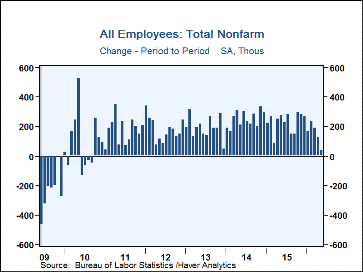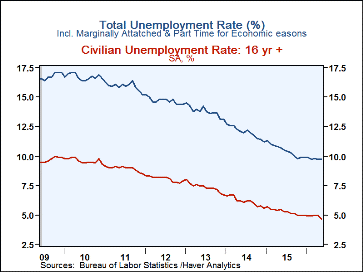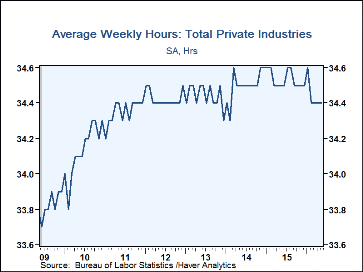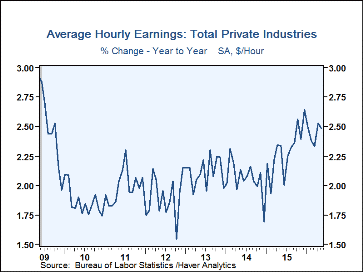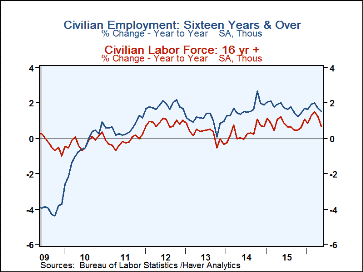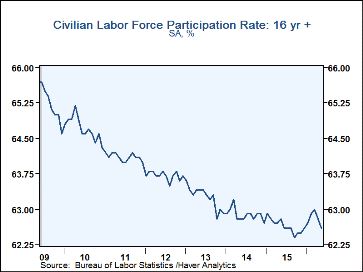 Global| Jun 03 2016
Global| Jun 03 2016U.S. Payroll Growth Disappoints
by:Tom Moeller
|in:Economy in Brief
Summary
Nonfarm payrolls grew just 38,000 (1.7% y/y) during May following downwardly revised gains of 123,000 and 186,000 during the prior two months. Revisions subtracted a combined 59,000 from April and March. It was the smallest increase [...]
Nonfarm payrolls grew just 38,000 (1.7% y/y) during May following downwardly revised gains of 123,000 and 186,000 during the prior two months. Revisions subtracted a combined 59,000 from April and March. It was the smallest increase since September 2010. A 154,000 increase had been expected in the Action Economics Forecast Survey. The strike by Verizon workers subtracted roughly 30,000 from last month's increase. Weaker job growth readings were widespread. The unemployment rate declined to 4.7% versus an expected 4.9%. The overall unemployment rate, including marginally attached and part-time for economic reasons, held steady at 9.7%. Average hourly earnings rose an expected 0.2% (2.5% y/y).
From the payroll survey, employment results were disappointing across sectors. Factory payrolls fell 10,000, construction employment declined 15,000 and mining payrolls fell 10,200. In the service sector, private employment rose 61,000, the weakest rise since June 2012. With Verizon workers added back in, the 91,000 worker increase still would have been the weakest since December 2013. Education & health services jobs grew 67,000 (3.1% y/y) and retail trade jobs employment gained 11,400 (2.1% y/y). Leisure & hospitality employment improved 11,000 (2.6% y/y) and financial activities jobs added 8,000 (1.9% y/y). Jobs in trade, transportation & utilities remained unchanged (1.6% y/y). Temporary help employment fell 21,000 (+0.6% y/y) and is down 2.2% since December. Government sector payrolls improved 13,000 (0.5% y/y). Federal government jobs rose 12,000 (1.0% y/y) and local government jobs grew 8,000 (0.5% y/y). State government employment fell 7,000 (+0.1% y/y).
The average workweek held steady at 34.4 hours, down from the expansion high of 34.6 in January.
The 0.2% rise in average hourly earnings followed a downwardly revised 0.4% increase. Nevertheless, the y/y increase of 2.5% remained up from 1.9% during all of 2012. Earnings in the mining & logging sector improved 4.1% y/y. Goods-producing sector earnings rose 3.0% y/y and in private services, they increased 2.4% y/y. Earnings in information services strengthened 5.0% y/y and in leisure & hospitality they gained 3.5% y/y. Professional & business services earnings rose 2.3% y/y and financial industry pay gained 2.1% y/y.
From the household survey, the unemployment rate's decline reflected a 26,000 worker increase (1.5% y/y) in employment, and a 458,000 decline (+0.7% y/y) in the labor force. The labor force participation rate declined to 62.6%, it's lowest level since December, and down from the March high of 63.0%.
The average duration of unemployment fell to 26.7 weeks, the lowest level since September.
The unemployment rate for those without a high school diploma fell to 7.1%, and for those with one but no college, it was 5.1%. Persons with less than a college degree realized 3.9% unemployment. For college graduates, the unemployment rate was 2.4%.
The labor market data are contained in Haver's USECON database. Detailed figures are in the EMPL and LABOR databases. The expectations figure is in the AS1REPNA database.
| Employment: (SA, M/M Change, 000s) | May | Apr | Mar | May Y/Y | 2015 | 2014 | 2013 |
|---|---|---|---|---|---|---|---|
| Payroll Employment | 38 | 123 | 186 | 1.7% | 2.1% | 1.9% | 1.6% |
| Previous | -- | 160 | 208 | -- | -- | -- | -- |
| Manufacturing | -10 | 2 | -29 | -0.3 | 1.1 | 1.4 | 0.8 |
| Construction | -15 | -5 | 37 | 3.4 | 4.8 | 5.0 | 3.7 |
| Private Service-Producing | 61 | 144 | 174 | 2.2 | 2.5 | 2.1 | 2.1 |
| Government | 13 | -7 | 19 | 0.5 | 0.5 | 0.0 | -0.3 |
| Average Weekly Hours - Private Sector | 34.4 | 34.4 | 34.4 | 34.5 (May'15) |
34.5 | 34.5 | 34.5 |
| Private Sector Average Hourly Earnings (%) | 0.2 | 0.4 | 0.2 | 2.5 | 2.3 | 2.1 | 2.1 |
| Unemployment Rate (%) | 4.7 | 5.0 | 5.0 | 5.5 (May'15) |
5.3 | 6.2 | 7.4 |
Tom Moeller
AuthorMore in Author Profile »Prior to joining Haver Analytics in 2000, Mr. Moeller worked as the Economist at Chancellor Capital Management from 1985 to 1999. There, he developed comprehensive economic forecasts and interpreted economic data for equity and fixed income portfolio managers. Also at Chancellor, Mr. Moeller worked as an equity analyst and was responsible for researching and rating companies in the economically sensitive automobile and housing industries for investment in Chancellor’s equity portfolio. Prior to joining Chancellor, Mr. Moeller was an Economist at Citibank from 1979 to 1984. He also analyzed pricing behavior in the metals industry for the Council on Wage and Price Stability in Washington, D.C. In 1999, Mr. Moeller received the award for most accurate forecast from the Forecasters' Club of New York. From 1990 to 1992 he was President of the New York Association for Business Economists. Mr. Moeller earned an M.B.A. in Finance from Fordham University, where he graduated in 1987. He holds a Bachelor of Arts in Economics from George Washington University.


